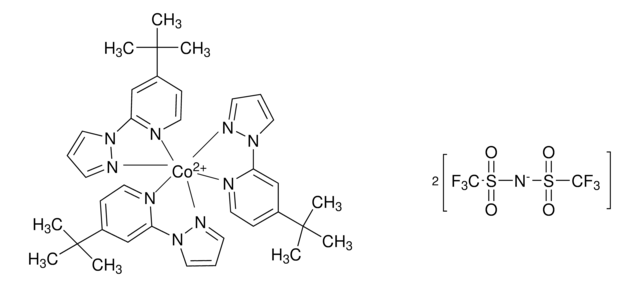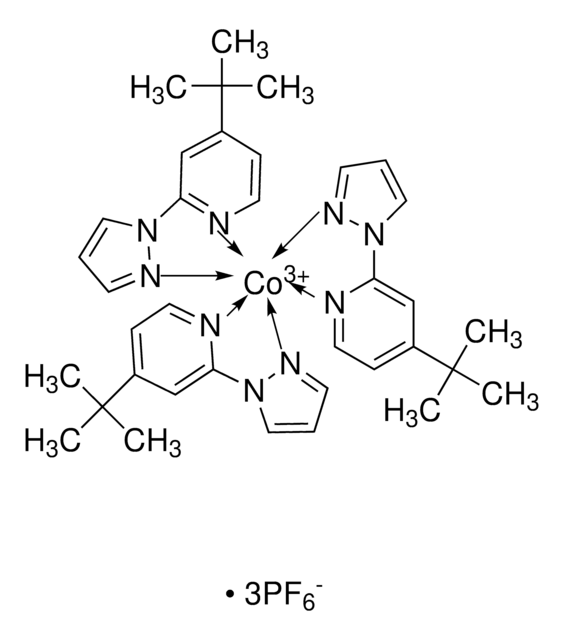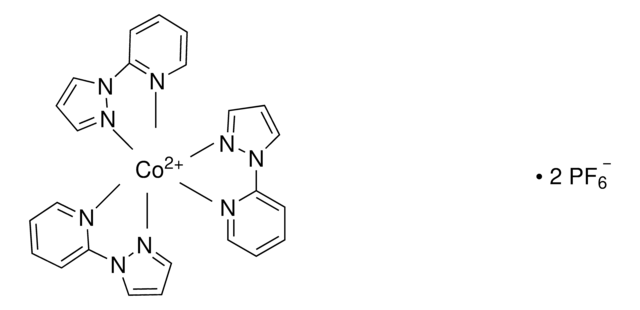805203
FK 102 Co(III) TFSI salt
Synonym(s):
tris(2-(1H-pyrazol-1-yl)pyridine)cobalt(III) tri[bis(trifluoromethane)sulfonimide
About This Item
Recommended Products
Assay
98%
Quality Level
form
powder
mp
194-199 °C
SMILES string
O=S([N-]S(=O)(C(F)(F)F)=O)(C(F)(F)F)=O.O=S([N-]S(=O)(C(F)(F)F)=O)(C(F)(F)F)=O.O=S([N-]S(=O)(C(F)(F)F)=O)(C(F)(F)F)=O.N1(C2=NC=CC=C2)N=CC=C1.C3(N4C=CC=N4)=CC=CC=N3.C5(N6C=CC=N6)=CC=CC=N5.[Co+3]
InChI
1S/3C8H7N3.3C2F6NO4S2.Co/c3*1-2-5-9-8(4-1)11-7-3-6-10-11;3*3-1(4,5)14(10,11)9-15(12,13)2(6,7)8;/h3*1-7H;;;;/q;;;3*-1;+3
InChI key
ILXRZLQXWLMDFQ-UHFFFAOYSA-N
General description
Application
Recommended use:
In liquid-based electrolytes: typically 0.15-0.2 M of Co(II) and ca. 0.05 M Co(II)
In solid-state photovoltaic cells: up to 10 weight % added to the hole transport material system.
Legal Information
Signal Word
Warning
Hazard Statements
Precautionary Statements
Hazard Classifications
Eye Irrit. 2 - Skin Irrit. 2 - STOT SE 3
Target Organs
Respiratory system
Storage Class Code
11 - Combustible Solids
WGK
WGK 3
Flash Point(F)
Not applicable
Flash Point(C)
Not applicable
Certificates of Analysis (COA)
Search for Certificates of Analysis (COA) by entering the products Lot/Batch Number. Lot and Batch Numbers can be found on a product’s label following the words ‘Lot’ or ‘Batch’.
Already Own This Product?
Find documentation for the products that you have recently purchased in the Document Library.
Articles
Next generation solar cells have the potential to achieve conversion efficiencies beyond the Shockley-Queisser (S-Q) limit while also significantly lowering production costs.
Dr. Perini and Professor Correa-Baena discuss the latest research and effort to obtain higher performance and stability of perovskite materials.
Dr. Perini and Professor Correa-Baena discuss the latest research and effort to obtain higher performance and stability of perovskite materials.
Dr. Perini and Professor Correa-Baena discuss the latest research and effort to obtain higher performance and stability of perovskite materials.
Our team of scientists has experience in all areas of research including Life Science, Material Science, Chemical Synthesis, Chromatography, Analytical and many others.
Contact Technical Service






![[6,6]-Phenyl C61 butyric acid methyl ester >99.5%](/deepweb/assets/sigmaaldrich/product/structures/359/221/d990c746-0960-4c69-bf76-fe09b193824d/640/d990c746-0960-4c69-bf76-fe09b193824d.png)
